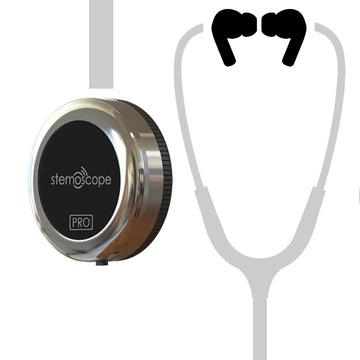Understanding Modern Stethoscopes: Digital, Electronic, Bluetooth, and Wireless

With the evolution of technology, traditional medical instruments have undergone significant transformations. Among these, the stethoscope, a primary tool for clinicians worldwide, has seen various modern iterations. Let's delve into the differences between digital, electronic, Bluetooth, and wireless stethoscopes and see how the Stemoscope PRO exemplifies the convergence of these technologies.
1. Electronic Stethoscope
What is it?
An electronic stethoscope amplifies the sound of a patient's heart, lungs, or other internal organs using electronic means. Some one also call it "electron stethoscope" or "electric stethoscope". If you search for an electron stethoscope, you may consider using a more popular search term for better result.
Key Features:
Amplification: It can increase the volume of body sounds, making it easier for healthcare professionals to detect abnormalities. One of the main objectives to make stethoscope electronic is to amplify the stethoscope sounds. Sometimes, it is difficult to hear the heart sounds or lung sounds, the electronic stethoscope is the first generation of amplified stethoscope for hard of hearing.
2. Digital Stethoscope
What is it?
A digital stethoscope not only amplifies sound but also converts acoustic sound waves into digital signals, which can be further processed, analyzed, or saved for future reference.
Key Features:
Sound Visualization: With the conversion to digital signals, some stethoscopes can visualize sound waves on a screen.
Recording: Physicians can save the auscultation data for later analysis or for sharing with colleagues.
Digital filtering: Advanced digital audio filtering can easily make the auscultation sounds better for either heart or lung.
3. Bluetooth Stethoscope
What is it?
A Bluetooth stethoscope utilizes Bluetooth technology to transmit auscultated sounds to another device, such as a smartphone, tablet, or computer. Some people also call it blue tooth stethoscope.
Key Features:
Wireless Transmission: Physicians can send the auscultation data to a device without a physical connection.
App Integration: Many Bluetooth stethoscopes come with dedicated apps that allow for visualization, analysis, and storage of the auscultation data.
4. Wireless Stethoscope
What is it?
While the term "wireless" often overlaps with Bluetooth, it's broader in scope. A wireless stethoscope can use other technologies besides Bluetooth, such as WIFI and 5G, to transmit data. However, most wireless stethoscopes mainly use Bluetooth technology. Sometimes, WIFI and Bluetooth could be mixed. Some people search for a WIFI stethoscope, but actually they search for a Bluetooth stethoscope.
Key Features:
Greater Range: Depending on the technology used, some wireless stethoscopes might offer a longer transmission range than Bluetooth-only devices.
Diverse Connectivity: These stethoscopes can connect to a wider range of devices or networks.
Stemoscope PRO: A Convergence of Technologies
The Stemoscope PRO exemplifies how a single device can incorporate all the above categories. Here's how:
Electronic: The Stemoscope PRO amplifies body sounds for clearer auscultation
Digital: It converts these sounds into digital signals, allowing for advanced processing and analysis.
Bluetooth: With its integrated Bluetooth technology, it can transmit sounds to a paired device without any cords.
As technology continues to advance, the lines between these categories may blur further, leading to more integrated and multifunctional tools for healthcare professionals. The Stemoscope PRO stands as a testament to how traditional medical devices can be revolutionized, offering clinicians enhanced capabilities and flexibility in patient care.
We'd Love to Hear From You!
Do you have any thoughts or experiences related to what we discussed today? Maybe a tip to share or a question to ask? Please feel free to leave a comment below. Your insights not only help us to improve our content but also create a vibrant community where we can all learn from each other. Don't be shy—drop us a line below!











